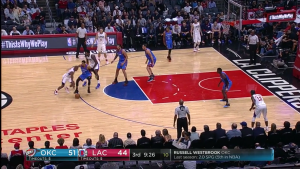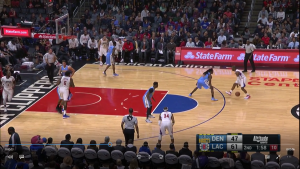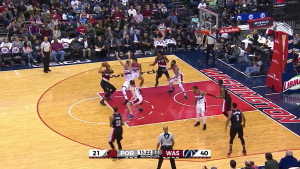Forty Percent or Bust: The Dizzying Highs of Added Spacing and Perilous Lows of Limited Shooters

Remember Highlights Magazine?
It’s a magazine full of funky games you played in the waiting room of the doctor’s office. From “hidden pictures” to “double check”, games existed that were fun for the whole family. My favorite one of those games was “spot the difference,” so let’s play a round of that now, only NBA-style.
For those of you who have never played it, it’s as simple as its name sounds. The objective is to find all of the differences between two pictures.
Going beyond the obvious “one is against the Denver Nuggets, and the other the Oklahoma City Thunder,” spot the discrepancies between these two clips of Chris Paul layups:
In both clips, Paul has a half step on his defender by the time he gets to the right elbow, and he explodes to the rim for a layup. But, like the GEICKO Gecko would say, spotting the difference in these clips is “so easy a caveman could do it.” In one, he makes the layup. In the other, he misses.
But why? He’s the “Point God,” a career 60.9 percent shooter at the rim; he rarely misses from that close.
The answer lies in another difference between the two clips. Watch them again. This time, look who is spotting up in the corner on the strong-side of the court.
Did you see it? In the clip where Paul misses at the rim, it was Luc Mbah a Moute. When he scores, it was J.J. Redick. That may not sound like a huge distinction, but this contrast in personnel is a big part of the reason behind the miss.
The reasoning is simple. Redick is a career 41.5 percent three-point shooter. Mbah a Moute, on the other hand, has shot a measly 32.4 percent from the same distance during his NBA tenure. Because the latter is not a threat to make a three, the man guarding him (Victor Oladipo, in this case) sags off and hangs out under the basket. His presence forces Paul to go for a reverse layup, which takes a split second longer to get off. That discrepancy allows his matchup, Andre Roberson, to get his hand in the driving point guard’s face and force the miss. Look how close to the paint Oladipo is standing right when CP3 starts his drive:

He’s basically on the block, ready to stop anyone coming to the rim. His M.O. at this moment is daring CP3 to kick it out to Mbah a Moute, but Paul tries for the tricky reverse instead and ends up failing. The Thunder win the possession.
In the Redick clip, the opposite is the case.
Because the Los Angeles 2-guard is consistently in the top five league-wide in three-point shooting percentage, Will Barton is forced to stay glued to him in the strong-side corner. This prevents him from stopping CP3 as he heads to the rim. As a result, Paul has an easy layup.
In contrast to Oladipo, look how far from the basket (read: close to Redick) Barton is when this drive starts:

No matter how the play goes, Barton will not allow the sharpshooter to get a good look in the corner, even if it compromises his ability to help on defense. The math is simple. A Paul layup yields, on average, 1.218 points throughout his career (that aforementioned 60.9 percent from within three feet multiplied by two). A Redick three calculates to 1.245 points per shot (41.5 percent from deep throughout his career, multiplied by three).
You live with the Paul layup because, statistically, that shot is the smarter shot to concede.
Juxtaposed with Redick’s points per shot, an Mbah a Moute three has an expected value of 0.972 points per attempt—almost a quarter of a point less than a CP3 look at the rim. The Thunder know this, so they have Oladipo hang out under the rim and contest the more valuable shot. Paul misses, Adams gets the rebound and the Thunder win the odds game.
Redick’s offensive impact, like most marksmen with a three-point percentage over 40, goes far beyond just shooting well from deep. The gravity he has beyond the arc forces opposing teams to keep a defender glued to him. This creates space for everyone else on LAC to do their thing on offense, and it shows. Of all Clippers lineups with 100 or more minutes, Redick is a part of the three best offensive groups, and four of the top five. Mbah a Moute is a part of just two of those lineups, and both of them also included Redick.
Even if Redick himself isn’t hitting shots, just having him in the game makes things happen for the Clippers on the offensive end. When he was on the court, the team shot 64.2 percent from five feet or less, versus 60.4 percent from the same distance when he sat; layups become easier when the five guys on the floor have more space. The opposite effect is true for Mbah a Moute, but to a lesser degree. When on the court, the Clippers shot 62.4 percent at the rim, versus 62.6 percent when on the bench.
On the off chance Mbah a Moute is knocking down his threes at an above-average rate (for him) during a game, he is still hurting his team’s offense just by being on the floor. Against Denver last December, Mbah a Moute made two of his three attempts from long range. He was still a minus-7 that night, and the team lost by four. The lack of help he brings the offense, even on his efficient nights, makes a massive difference. And as a result, it can be hard to keep him—and other non-shooters—involved in the action against smarter defensive lineups.
The group of 40 percent shooters from deep is full of players who make an offense click, including Cleveland Cavaliers sharpshooter Channing Frye.
He shot 40.9 percent from downtown last season, good for his second-best career season from deep. When he played, he took a big man away from the basket by stretching beyond the three-point line, and the Cavs were able to shoot 66.3 percent at the rim with him on the court. When he sat? That number dropped to 62.1 percent. He makes things happen by doing nothing more than standing 25 feet from the basket. Even Deron Williams, who has lost a few steps from his heyday, can be the beneficiary of Frye’s presence, like he is here:
Now let’s do the same math problem that we did earlier.
Williams shot 54.3 percent at the rim last year, or 1.086 points per attempt. Frye from deep yields 1.227 points per shot. Nikola Jokic knows this, so he stays a little closer to Frye than he would a lesser three-point shooter (smartly, though it just didn’t work) and the lane opens right up for D-Will. Sorry, Nuggets fans, I’m not trying to pick on you!
Frye has essentially no impact on the defensive end; the Cavs sacrificed almost 40 points on defense because of him last season, per NBA Math’s defensive points saved. Despite this, he had a plus/minus of plus-62 last year, meaning over the course of the whole season Cleveland outscored its opponents by 62 points when he was on the court. The big man is truly a one-trick pony when it comes to outside shooting, but he is so good at it that the Cavaliers can succeed in his minutes, even with him serving as a liability at just about every other skill.
In short, if you’re a great three-point shooter, you’re an effective player. That isn’t a secret. If Deron Williams has enough space to get to the rim, your lineup has effective spacing. Plain and simple. However, the opposite side of this statistical reality is arguably more important. Bad shooters are much harder players to acclimate for than good ones.
Mbah a Moute was just one example. He hindered the talents of one of the best point guards of all time when he is on the floor. But many others have this problem. Another who stalls his team’s offense just by being on the court is Portland Trail Blazers forward Evan Turner.
Turner, like Mbah a Moute, struggles from downtown. A career 29.8 percent deep shooter, Turner has never particularly excelled from beyond the arc, but last season was even worse than normal. He shot just 26.3 percent, good for the second-worst season of his career.
And it crippled Portland on offense.
When Damian Lillard and C.J. McCollum, two of the leagues most prolific scorers, shared the court with Turner, the offense stalled. Out of all 47 three-man lineups Portland used with 300 or more minutes logged over the course of the season, this trio posted the 35th-best offensive rating. The Blazers scored eight points per 100 possessions more with Turner on the bench than they did when he played. Most importantly, the team was able to shoot almost 58 percent at the rim when he sat. When he played, that number dropped almost 3 percent, all the way down to 54.6.
Yikes.
Having a player who makes it harder for your two stars to play their roles effectively is never good. Even when Turner is knocking down his deep ball, he doesn’t help the offense. Against Washington in January, Turner drained both of his attempts from long range, and yet he was still a minus-9. On this possession in particular, his presence made it very challenging for the Blazers to finish. Portland ran a pick-and-roll for Turner at the elbow instead of behind the arc, largely because he can’t knock it down from deep. This created a huge cog of players in the lane, and soon after ET dished it to Maurice Harkless, his teammate was surrounded by defenders. As a result, he had to go for a tougher finish and missed his layup in a morass of arms:
Seriously, look what Harkless has to deal with right before he gets the ball. Four defenders are in the paint—all within a few feet of him—because the Blazers couldn’t space the floor:

During this stretch of Turner play, the Wizards outscored the Blazers 16-4 over five minutes. Remember, this was Turner’s best shooting performance of the season, and he was still ineffective in his minutes. How can Portland continue to put him on the court when he hurts the team, even on his best shooting nights?
That’s the challenge.
Portland, like every other team in the league, is looking to avoid this problem by adding more guys who can shoot over 40 percent from deep. But that can be a difficult task. Last season, only 35 such players existed in the entire NBA who connected at that rate with over 100 attempts. The two teams that made the finals, the Golden State Warriors and Cleveland Cavaliers, had 14 percent of these players.
Making a point to get more of these guys can drastically improve your offense; that’s why Cleveland has sent away a first-round pick for both Frye and Kyle Korver over the last two seasons. Guys like Otto Porter Jr. and Joe Ingles just received huge paydays because their incumbent teams were afraid of losing their marksmen. The Brooklyn Nets just took on Allen Crabbe’s monster contract to add shooting. Even Jodie Meeks, who has played only 39 games the last two seasons due to injuries, was able to find a two-year deal because of his shooting ability. These guys are in high demand, and the tapes show why.
With the league shifting toward having as many as five shooters on the court at once, look for these guys to be in high demand in the coming seasons. Don’t be surprised to see players like Darrell Arthur, Mike Muscala and Arron Afflalo carve out larger roles on their current teams, or become trade candidates in January, due to their shooting abilities. Meanwhile, expect guys like Turner, Stanley Johnson and Jeremy Lamb see a reduction in minutes for the same reason.
There’s no telling just how far this era of shooting can go. Have we seen the maximum impact three-point shooting can have on an offense, or is there another level coming for spacing? Only time will tell, but these shooters will continue to be vastly more popular than other player types in the meantime.
Follow Tony on Twitter @TEastNBA.
Follow NBA Math on Twitter @NBA_Math and on Facebook.
Unless otherwise indicated, all stats are from NBA Math, Basketball Reference or NBA.com.
